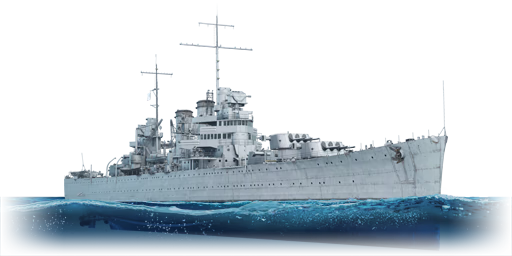USS Brooklyn
Contents
Description
The Brooklyn-class, USS Brooklyn (CL-40), 1941 is a rank American light cruiser
with a battle rating of (AB), (RB), and (SB). It was introduced in Update 1.87 "Locked On".
General info
Survivability and armour
Talk about the vehicle's armour. Note the most well-defended and most vulnerable zones, e.g. the ammo magazine. Evaluate the composition of components and assemblies responsible for movement and manoeuvrability. Evaluate the survivability of the primary and secondary armament separately. Don't forget to mention the size of the crew, which plays an important role in fleet mechanics. Tips for preserving survivability should be saved for the "Use in battle" section.
If necessary, use a graphic template to show the most well-protected or most vulnerable points in the armour.
Mobility
Write about the ship’s mobility. Evaluate its power and manoeuvrability, rudder rerouting speed, stopping speed at full tilt, with its maximum forward speed and reverse speed.
Armament
Primary armament
- 15 x 6-inch/47 caliber Mk. 16 guns in five triple turrets.
Secondary armament
Some ships are fitted with weapons of various calibres. Secondary armament is defined by the weapon chosen with the control Select secondary weapon. Evaluate the secondary armament and give advice on how to use them. Describe the ammunition available for the secondary armament. Provide recommendations on how to use them and which ammunition to choose. Remember that anti-air armament, even heavy calibre weapons, belong in the next section.
If there is no secondary armament, remove this section.
Anti-aircraft armament
An important part of the ship’s armament responsible for air raid defence. Anti-aircraft armament is defined by the weapon chosen with the control Select anti-aircraft weapons. Talk about the ship’s anti-air cannons and machine guns, the number of guns and their positions, their effective range, and about their overall effectiveness – including against surface targets.
If there is no anti-aircraft artillery, remove this section.
Usage in battles
Describe the technique of using this ship, the characteristics of her use in a team and tips on strategy. Abstain from writing an entire guide – don’t get try to provide a single point of view, but give the reader food for thought. Talk about the most dangerous opponents for this vehicle and provide recommendations on fighting them. If necessary, note the specifics of playing with this vehicle in various modes (AB, RB, SB).
Modules
| Tier | Seakeeping | Unsinkability | Firepower | |||
|---|---|---|---|---|---|---|
| I | Dry-Docking | Tool Set | 6 inch Mk.35 AP | Anti-Air Armament Targeting | ||
| II | Rudder Replacement | Fire Protection System | Smokescreen | 6 inch Mk.34 HC | Auxiliary Armament Targeting | |
| III | Propeller Replacement | Ventilation | Shrapnel Protection | 5 inch Mk.28 AAC-VT | Primary Armament Targeting | Improved Rangefinder |
| IV | Engine Maintenance | New Pumps | Ammo Wetting | 6 inch Mk.34 HC | ||
Pros and cons
Pros:
- Great broadside firepower for a cruiser
- Fairly resilient to small-calibre rounds
Cons:
- Can't carry torpedoes
- Very light AA defence (not including the 5-inch guns)
- Rather slow compared to PT boats
History
In 1930, the London Naval Treaty extended the limitations imposed by the Washington Naval Treaty by further limiting the construction of large warships. Well-aware of the importance of such warships for operations in the Pacific, the U.S. Navy initiated the development of a new light cruiser design that would suit their needs, whilst remaining within the limitations of both treaties. The new design, that would become the Brooklyn-class light cruisers, was a compromise between heavy cruiser size and protection and light cruiser armament. In other words, the ship would remain within the 10,000 ton displacement limit, but would also offer the desired seaworthiness and autonomy at the same time. Initially, the ship was intended to carry only a dozen 6-inch main guns. However, with the appearance of the Japanese Mogami-class cruiser, a decision was hastily made to increase the number of main guns to 15, in order to match the armament of the Mogami-class. With this choice, the Brooklyn-class cruisers would become the most heavily armed light cruisers ever built for the USN. The first orders for four ships were issued in 1933, followed by an additional three in 1934. The lead ship of the class, USS Brooklyn (CL-40), was laid down in March 1935 and commissioned into service in September 1937. USS Brooklyn primarily served in the Mediterranean theater during WW2, participating in the North African campaign and later on in the Italian campaign. The ship mostly served as a support in landing operations and performed coastline bombardments, while also engaging in the occasional naval skirmish. Soon after the end of WW2, USS Brooklyn was decommissioned in 1947 and handed over to the Chilean Navy in 1951 under the new name of O’Higgins (CL-02). The ship would continue to serve on with the Chilean Navy for over 40 years, before being sold for scraps in 1992.
- From [[Devblog
Media
An excellent addition to the article will be video guides, as well as screenshots from the game and photos.
See also
Links to the articles on the War Thunder Wiki that you think will be useful for the reader, for example:
- reference to the series of the ship;
- links to approximate analogues of other nations and research trees.
External links
| USA light cruisers | |
|---|---|
| Omaha-class | USS Detroit · USS Raleigh · USS Trenton |
| Atlanta-class | USS Atlanta |
| Brooklyn-class | USS Brooklyn · USS Helena |
| Cleveland-class | USS Cleveland |
| Fargo-class | USS Fargo |
| Worcester-class | USS Roanoke |





